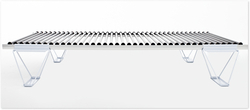The solar panels from Solyndra are a little different than the rest.
Instead of the flat-as-a-pancake solar panels we’ve grown to know and love, these panels are a series of tubes (just like the internet).
They look something like a bunch of dark fluorescent lighting tubes that have been laid down together with a little space between them. Instead of producing light, however, these tubes suck in the light and turn it into pure solar power goodness.
Since these “panels” and their mounting system are designed for flat roofs, they probably won’t work on your house. The company’s market is generally the commercial and industrial sector where big flat roofs are the norm.
If you have a commercial rooftop in need of a solar solution should you consider these tubes for the job?
In other words: Are these fancy panels just a fashion statement or do they represent a better investment of your hard earned dollars?
It turns out that there are actually some potential advantages to going with the company’s novel solar solution. Let’s take a look at a few of these advantages:
- 360 Degrees of Solar
The cylindrical design of the solar modules allows them to receive sunlight from every angle. This allows you to take advantage of any light available, including “direct, diffuse and reflected sunlight” and more light should equal more power. To take advantage of the “reflected sunlight”, however, you will need a white roof. The good news is that white roofs deflect heat and decrease air conditioning costs, offering better energy efficiency.
- Lightweight
Ever heard of “value engineering”? It involves lowering costs by designing something to only do what it is supposed to do. The adoption of this idea means that the load bearing capacity of many commercial roofs can’t handle much extra weight. Fortunately these tubular modules are relatively lightweight (2.8 pounds per square foot) and are therefore well-suited for most commercial roofs.
- No Roof Punctures
The design of Solyndra’s modules and racking system allow a quick, puncture-free installation. This is partly due to the fact that air movement between the “solar tubes” means that there is less wind lift than with traditional solar panels (which can sometimes act like a sail). The decreased wind lift allows these modules to be installed without roof punctures or a ballasted mounting system (using weights).

Well all of that sounds pretty good, but you might be wondering if there are any disadvantages to Solyndra that you should know about? There aren’t any “deal breakers” at this point but here are a couple of things you should be aware of:
- CIGS
Solyndra uses a thin film solar cell technology called CIGS which stands for copper, indium, gallium, and selenide (these four amigos make up the semiconductor material of the panels). CIGS technology is the most efficient of the thin film varieties but still not quite as efficient as crystalline silicon panels.
- High Cost
The production process for CIGS solar cells makes it difficult for these solar modules to compete with the lower prices of other thin film solar companies. A 2010 article reported that Solyndra’s manufacturing costs were approximately $3.00 per watt, while thin film competitor First Solar had costs of $0.81 per watt. The company’s new CEO has made cost reduction his number one goal but you should still make sure you’re not paying too much for your tubular solar solution.
Hopefully you’ve got a better idea about whether these unique solar modules are right for your commercial building. On the positive side, these panels are well-rounded (literally), they don’t weigh too much and you don’t have to put any holes in your roof (and possibly void a warranty).
Just be sure you’re getting all the solar panel efficiency you need and that you are not paying too much for your solar solution.
There is room out there for many different kinds of solar panels and Solyndra has definitely added an interesting option to the list.
September 2011 Update: Turn out the lights, the party’s over. Solyndra has announced that it intends to file for bankruptcy protection despite receiving $535 million in federal loans. It seems that the company was unable to compete with lower cost panels from China.
